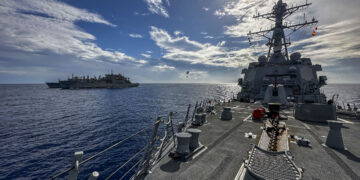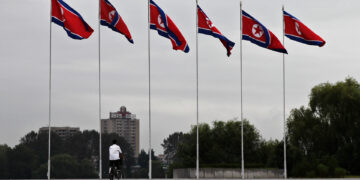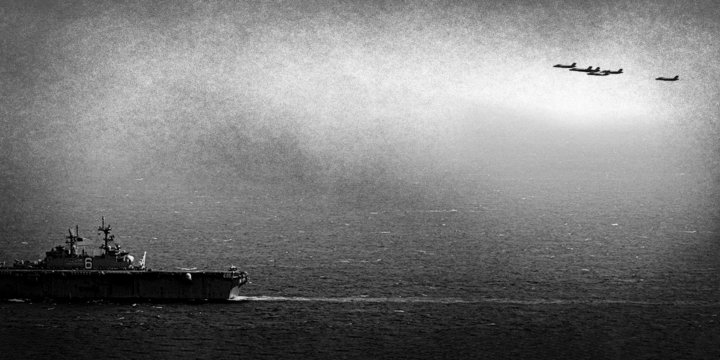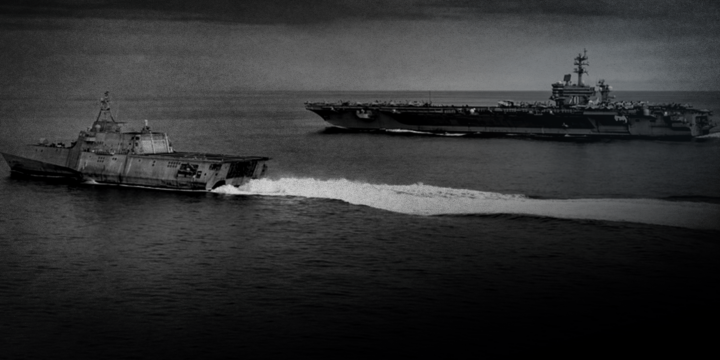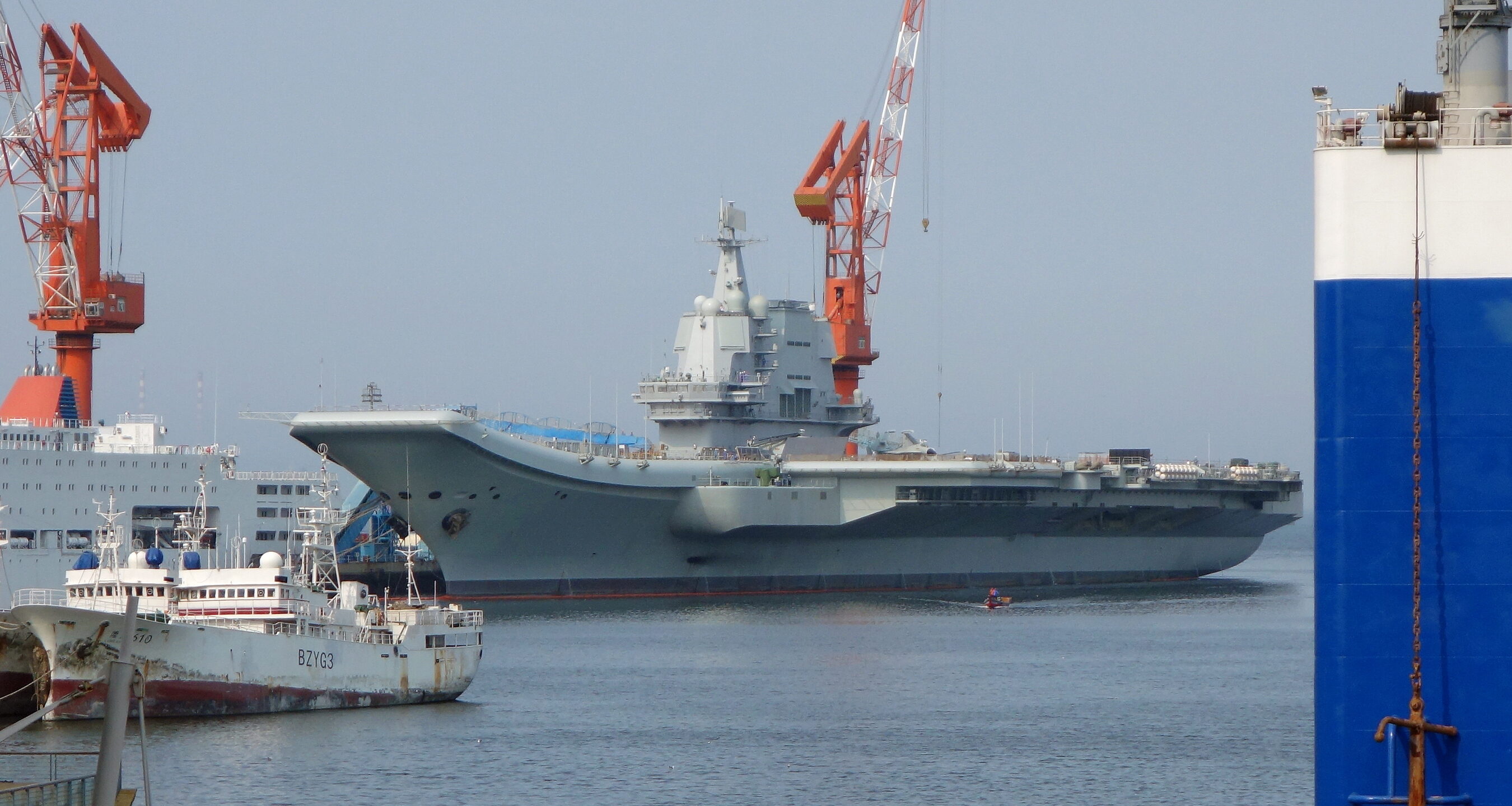
Key points
- China has steadily built up its maritime capabilities over the past three decades, giving it the ability to contest its littoral seas in the event of conflict. But significant challenges remain before it can control those waters, let alone the broader Pacific Ocean.
- A combination of factors—including geography, the capabilities of other regional states, technological questions, and Beijing’s own dubious procurement choices—work to dampen China’s maritime potential.
- Taiwan remains an inflection point for Chinese maritime ambitions. Without decisive control of the island, China is constrained in its efforts to project force further into the Pacific. Currently, though, China lacks the means to accomplish a successful invasion of the island.
- Particular areas of weakness in China’s maritime capabilities include undersea warfare, amphibious lift, and aerial refueling capabilities.
Limitations on Chinese maritime capabilities
It is at sea where the greatest likelihood exists for a direct clash between Chinese and U.S. forces. Specifically, the Western Pacific is the most likely site of open conflict between this era’s two most prominent powers—just as the plains of Central Europe once were the central flashpoint between the Soviets and Americans. Accurately calibrating the strengths and weaknesses of Chinese maritime power is therefore essential in determining U.S. risk and potential responses.
Geographical constraints on China’s maritime power
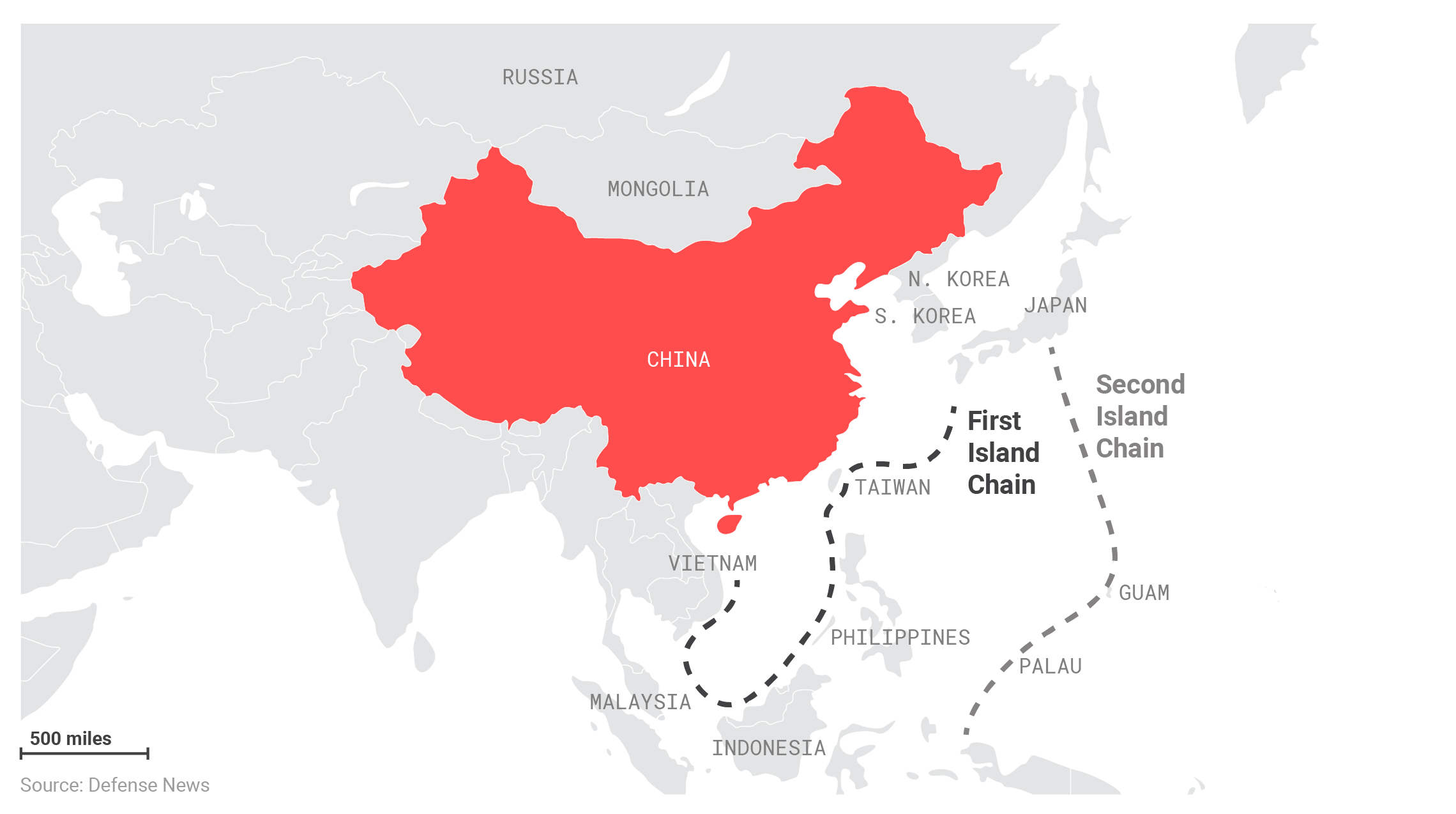
Asia’s first and second island chains, formed by the various islands of the East and South China Seas, create natural bottlenecks that shape regional maritime dynamics.
China’s current program of naval modernization dates from the mid-1990s. In the intervening quarter century, China has put to sea two aircraft carriers and dozens of other modern surface combatants, all while expanding its holdings of both nuclear and diesel electric submarines. In the last 15 years alone, its inventory of “battle force ships”—those with a direct or supporting combat role—has increased by 119 and the overall size of the People’s Liberation Army Navy (PLAN) now surpasses the U.S. Navy, at 360 battle force ships as compared to 297.1It should be noted there is some room for interpretation in these figures, as the U.S. Navy counts certain ships as “battle force,” such as auxiliary and supply, while China does not; however, the PLAN does count patrol craft, unlike the U.S. Navy. See “Table 2. Numbers of Battle Force Ships, 2000–2030,” in U.S. Library of Congress, Congressional Research Service, “China Naval Modernization: Implications for U.S. Navy Capabilities—Background and Issues for Congress” (RL33153), August 24, 2020, 29–30, https://fas.org/sgp/crs/row/RL33153.pdf. A DoD assessment released in September 2020 offered a similar but slightly different tally of 350 PLAN ships versus 293 for the U.S. Navy. See Office of the Secretary of Defense, “Annual Report to Congress: Military and Security Developments Involving the People’s Republic of China,” Government Printing Office, 2020, ii. China has also implemented a much-vaunted concept of sea denial in its littoral region. Known as anti-access/area denial (A2/AD), the concept entails the use of a network of sensors and ballistic and cruise anti-ship missiles to ostensibly render China’s littoral zone impenetrable.
But the extent of effort by China to enhance its maritime capabilities is also striking in what it has not achieved. It is little closer to controlling the East, South, and Yellow Seas to the exclusion of other naval forces; nor does it possess the means at this time to decisively invade, occupy, and garrison Taiwan. In a war, could the PLAN contest its littoral wars? Of course. But to suggest it could decisively shut down those waters to all outside shipping, either commercial or military, is to overrate its current capabilities. And A2/AD remains an untested concept—potentially potent, yes, but still unproven in practice.
There also is the central question of how the various air and naval platforms China has produced this century will perform together. As recently as the 1990s, China’s concept of “jointness” (meaning coordination across services) consisted of the PLA’s constituent services simply conducting separate, independent operations in the same general vicinity.2Dennis J. Blasko, Phillip T. Klapakis, and John F. Corbett, Jr., “Training Tomorrow’s PLA: A Mixed Bag of Tricks,” China’s Military in Transition, eds. David Shambaugh and Richard H. Yang (New York: Oxford University Press, 1997), 253. As with all things military, China has made strides in this area during the twenty-first century, repeatedly trying to infuse the concept of jointness into its operations and structures.3This is a point repeatedly touched on in Office of the Secretary of Defense, “Annual Report to Congress.” But it remains to be seen how effectively it can apply the various pieces of its arsenal in an integrated fashion during a sustained campaign. For the moment, China’s remains a regional navy that is not yet prepared to challenge the U.S. Navy for global dominance, or even primacy, in the Western Pacific.4This point was made by Secretary of Defense Mark Esper in a recent speech. In his words, “I want to make clear that China cannot match the United States when it comes to naval power. Even if we stopped building new ships, it would take the PRC years to close the gap when it comes to our capability on the high seas. Ship numbers are important, but they don’t tell the whole story. They do not address the types of ships and the capabilities of the vessels being counted; the skill of the crews that operate them; the prowess of the officers that lead them; or the ways in which we fight and sustain them … just to name a few.” See Mark T. Esper, “Secretary of Defense Speech at RAND (As Delivered),” U.S. Department of Defense, September 16, 2020, https://www.defense.gov/Newsroom/Speeches/Speech/Article/2350362/secretary-of-defense-speech-at-rand-as-delivered/.
Accurately gauging China’s maritime power is no academic exercise. The prospect of a new cold war between China and the U.S. is now a central issue in international affairs. And it is, again, at sea in the East Asian littoral where any conflict between the two states is likely to turn hot. Yet such a conflict need not be a foregone conclusion.5Daniel L. Davis, “Responsibly Competing with China,” Defense Priorities, July 2020, https://www.defensepriorities.org/explainers/responsibly-competing-with-china. Recognizing there remain limitations on Beijing’s current maritime capabilities could provide an additional break on a spiral into deeper conflict between China and the U.S.
From the U.S. side, such clarity of vision could provide crucial time to consider how deeply it wants to commit itself to new regional alliances, how willing it must be to compromise with questionable regimes to contain China, and how much of its increasingly scarce resources it wants to devote to the challenge posed by China in the Western Pacific. None of this is to argue Chinese maritime capabilities can be ignored outright or they are not an important long-term consideration in regional defense planning. But it is to say there is still time to calibrate more thoughtfully the U.S. response.
For that reason alone, a closer look at the limitations on Chinese maritime capabilities is warranted. At least five major factors work against Chinese naval dominance, and while some—such as technological issues and procurement choices—could resolve themselves in time, other areas are more lasting and will continue to affect Chinese ambitions even as Beijing continues to invest further in its fleet and attendant capabilities.
Outdated designs in key Chinese platforms
The scale of China’s naval modernization effort this century is impressive. China has enhanced not just the PLAN’s raw tonnage, but also dramatically increased the number of vertical launch system (VLS) cells it can deploy.6Toshi Yoshihara, Dragon Against the Sun: Chinese Views of Japanese Maritime Seapower (Washington, DC: Center for Strategic and Budgetary Assessments, 2020), 12–15, https://csbaonline.org/research/publications/dragon-against-the-sun-chinese-views-of-japanese-seapower/publication/1. VLS cells are essentially the chambers in the collective gun of a navy. They are the means for launching various missiles: anti-ship, anti-air, and land attack. The more VLS cells a fleet has, the more firepower it wields. To this end, China has done a good job of fielding an array of cruisers, destroyers, and frigates at a time when the U.S. Navy’s ability to recapitalize these same assets has been called into question. China further has outfitted them with a highly capable anti-ship cruise missile (ASCM), the YJ-18, which significantly outranges its main U.S. counterpart, the Harpoon.7See the discussion of the YJ-18 versus Harpoon ranges in Yoshihara, Dragon Against the Sun, 16; Lyle Goldstein, “The U.S.-China Naval Balance in the Asia-Pacific: An Overview,” China Quarterly, no. 232 (December 2017): 912–913. But while it deserves kudos for this element of its surface fleet, the PLAN is also qualitatively lacking in two other core areas of modern naval strength—aircraft carriers and nuclear attack submarines (SSNs).
Chinese carriers are not equivalent to their U.S. counterparts
That China has aircraft carriers at all has come to be taken as a sign of its ascendance to great power status. Yet as frequently as they are invoked, little attention is given to what these platforms are actually capable of, with it often assumed they are roughly equivalent to their U.S. counterparts. The reality is quite different. Both Chinese carriers—the Liaoning and the Shandong—are derivatives of a 40-year-old Soviet design. Unlike U.S. carriers, they are conventionally powered (not nuclear) and do not possess advanced steam catapult technology. This is why they have a curved “ski-jump” front; their aircraft need the incline to attain liftoff since they are unaided by a catapult, as in the U.S. case. The Chinese carriers are also smaller and put to sea with a more modest airwing than their American counterparts—from 30 to 40 aircraft (fixed wing and helicopters) as opposed to more than 60 in the U.S. case.8Congressional Research Service, “China Naval Modernization,” 11–13.
These differences are not just cosmetic. Without nuclear power, the carriers are limited in overall range. Without steam catapults, their aircraft are constrained in the amount of fuel and ordnance they can carry. The requirement to take off without catapult assistance thus greatly compromises what the aircraft can do once in the air because their range is restricted (by less fuel) and their firepower impeded (by less ordnance).9Congressional Research Service, “China Naval Modernization,” 13.
In battle, the Chinese carriers are more likely to deploy their fighters in an air defense role rather than strike deep into an opponent’s territory. It would be wrong to call China’s aircraft carriers mere status symbols without any combat function at all, but it is important to contextualize what this capability really represents in terms of warfighting ability when discussing “Chinese carriers.”10China has laid the keel down on its first flat-deck carrier, which will approach its U.S. counterparts in size, though is not expected to be nuclear. It is also believed to be fitted with catapult launch systems, possibly electro-magnetic ones like those employed by the U.S. Navy’s newest carrier, the USS Gerald Ford. But this third carrier is not yet a demonstrated capability—or a fleet. The carrier is not anticipated to be operational until 2024, and that assumes China is able to master catapult technology without any complications—something that bedeviled the Ford’s development. Even then, one carrier would only be available for part of the year due to maintenance and training requirements. See Office of the Secretary of Defense, “Annual Report to Congress,” 47; Gary Shih, “China’s Third Aircraft Carrier Takes Shape, with Ambitions to Challenge U.S. Naval Dominance,” Washington Post, September 16, 2020, https://www.washingtonpost.com/world/asia_pacific/chinas-third-aircraft-carrier-takes-shape-with-ambitions-to-challenge-us-naval-dominance/2020/09/16/d1068f8c-f674-11ea-85f7-5941188a98cd_story.html.
Quieting issues with Chinese SSNs and SSBNs
Qualitative shortcomings also affect China’s primary nuclear undersea assets. The PLAN’s frontline SSN, the Shang-class, is generally assessed to have a similar quieting-level to the Soviet Victor III, a design that first put to sea in the late 1970s.11Owen R. Cote, Jr., “Assessing the Undersea Balance between the U.S. and China,” MIT Security Studies Program (SSP) Working Paper, February 2011, 11–12, https://www.usni.org/sites/default/files/inline-files/Undersea%20Balance%20WP11-1.pdf. This is significant because the Victor III was the main submarine the Soviets deployed before making acoustic breakthroughs that led to the super-quiet Akula SSN, which entered service in the mid-1980s. The Akula was the first Soviet (then Russian) submarine that could not be detected by the U.S. string of underwater microphones—better known as the Surveillance Sound System, or SOSUS.12Cote, “Assessing the Undersea Balance between the U.S. and China,” 7.
Notional detectability of Chinese nuclear submarines

China lags behind other modern navies in terms of its nuclear undersea capabilities. It currently operates SSNs and SSBNs louder than Soviet/Russian designs first put to sea in the 1970s (Delta III) and 1980s (Akula).
Current Chinese SSNs are therefore still detectable by SOSUS. This matters because the U.S. has deployed SOSUS (and potentially other more advanced underwater detection devices) in a “fishhook” stretching roughly from Japan to the Andaman and Nicobar Islands, ringing the East Asia littoral seas.13For a full discussion on the SOSUS “fishhook,” including a map of its coverage, see Desmond Ball and Richard Tanter, The Tools of Owatatsumi: Japan’s Ocean Surveillance and Coastal Defence Capabilities (Canberra: Australian National University Press, 2015), 51–54. As such, it is likely no Chinese nuclear attack submarines can leave that area without detection—a major advantage for the U.S. in undersea competition in the Pacific.
Poor acoustic performance also applies to China’s main nuclear ballistic missile submarines (SSBNs), the Jin-class. Although they are strategic systems without direct bearing on a conflict in the Western Pacific, that the Jin, too, underperform relative to comparable systems is representative of the technological challenges China has yet to master. According to Office of Naval Intelligence estimates, the Jin is louder than Russia’s Delta III SSBN, which also first put to sea in the late 1970s.14Regarding the Jin’s quieting characteristics, see the chart “Submarine Quieting Trends” in Office of Naval Intelligence, “The People’s Liberation Army Navy: A Modern Navy with Chinese Characteristics,” August 2009, https://fas.org/irp/agency/oni/pla-navy.pdf; Jeffrey Lewis, “How Capable Is the Type 094?” Arms Control Wonk, July 31, 2007, https://www.armscontrolwonk.com/archive/201579/how-capable-is-the-094-23/; and Hans M. Kristensen, “China’s Noisy Nuclear Submarines,” Federation of Atomic Scientists, November 21, 2009, https://fas.org/blogs/security/2009/11/subnoise/.
Consider then that China’s nuclear attack submarines are noisier than SSNs the Soviet Union was making 35 years ago and its SSBNs are less quiet than their Soviet counterparts from more than 40 years ago. These shortcomings—along with the limitations of the Liaoning and Shandong—illustrate the news is not all positive with respect to the PLAN’s development. While its numerical advances in surface combatants and VLS capacity are impressive, the fleet as a whole remains of uneven quality.
Current and projected Chinese submarine forces

The U.S. Office of Naval Intelligence projects by 2030 China will have a moderately larger number of ballistic missile and nuclear-powered attack submarines but no overall increase in diesel electric submarines.
Capabilities gaps in maritime strike aircraft
The quality of the air capabilities the PLAN and the People’s Liberation Army Air Force (PLAAF) will bring to bear over East Asia’s littoral zones is also questionable. The backbone of China’s air force consists of imported or indigenously produced variants of the old Soviet Flanker design, the Su-27.15DoD estimates that more than half of the PLAAF’s and PLAN’s fighter inventory consists of modern fourth-generation aircraft (like the Su-27 and its variants), specifically about 800 out of total 1,500 planes. See Office of the Secretary of Defense, “Annual Report to Congress,” 50. It is a venerable air frame and, with improvements the Chinese have made, some variants, such as the J-16, could be considered advanced fourth-generation capabilities, possibly on par with the U.S. Air Force’s F-15X or the U.S. Navy’s F-18E/F. But neither the PLAAF nor the PLAN have anything approaching the fifth-generation capabilities of the F-22 or the F-35.
China does have what it considers to be a stealth fighter in early production, called the J-20. But some analysts have questioned whether it constitutes a true low-observable aircraft.16See, for example, the comments by Michael Kofman in Daniel Brown, “We Asked a Military Analyst How the F-22, Su-57, and J-20 Stealth Planes Match Up,” Business Insider, March 7, 2018, https://www.businessinsider.com/comparison-of-f-22-su-57-and-j-20-stealth-planes-2018-3. China has encountered problems developing the J-20’s engine, instead substituting alternate power plants that leave current models of the J-20 underpowered.17Alternate engines for the J-20 have included Russian imports and the domestically produced engine for the J-16, but neither is explicitly designed for the J-20. For more on the challenges affecting development of the J-20’s intended engine and discussion of alternate domestic and Russian substitutes, see Kofman’s comments in Brown, “We Asked a Military Analyst”; Caleb Larson, “China’s J-20 Stealth Fighter is Getting an Upgrade—Thanks to Russia,” National Interest, July 20, 2020, https://nationalinterest.org/blog/buzz/china%E2%80%99s-j-20-stealth-fighter-getting-upgrade%E2%80%94thanks-russia-165242; Rick Joe, “China’s J-20 Stealth Fighter Today and Into the 2020s,” Diplomat, August 16, 2019, https://thediplomat.com/2019/08/chinas-j-20-stealth-fighter-today-and-into-the-2020s/. In general, the J-20 is perhaps better described as a very advanced fourth-generation plane (assuming it works as advertised), but it does not approximate the true-stealth abilities of the F-22 or F-35, the latter of which will eventually be operated in large numbers by both South Korea and Japan, as well the U.S. As with “carrier,” the term “stealth fighter” should thus not be taken as a one-to-one equivalency to U.S. assets when looking at China’s inventory.
Questionable Chinese procurement choices
During the Cold War, it was said the Pentagon acted “like a bachelor who owned a Porsche but forgot to pay his electric bill.”18Michael R. Gordon and Bernard E. Trainor, The Generals’ War (New York: Little, Brown, and Company), 1995, 57. The implication was the Department of Defense (DoD) bought big-ticket items but often ignored more mundane capabilities that were nevertheless essential. For example, the U.S. Navy’s paucity of minesweepers was frequently cited in comparison to its glut of aircraft carriers.19This was a particular source of ire for General Norman Schwarzkopf, who lamented the Navy’s paucity of minesweepers and inability to clear Iraqi sea mines in support of a planned amphibious landing during the 1991 Gulf War. Instead, the Navy suffered two ships damaged to mines, including a new Aegis cruiser, the USS Princeton, and the ship leading the mine-clearing effort, the USS Tripoli. See Rick Atkinson, Crusade: The Untold Story of the Persian Gulf War (New York: Houghton Mifflin Company, 1993), 237–240, 321–330. There is something oddly comforting in knowing that the Chinese procurement system may have similar blind spots.
Under-investment in anti-submarine warfare
Although the naval tonnage the PLAN has been able to field this century is impressive, there are specific capabilities where China has strangely chosen not to invest. Up until recently, one of the most glaring areas was in the realm of anti-submarine warfare (ASW). For most of this century, most PLAN ships lacked basic ASW capabilities like towed array sonar systems (TASS), and almost no ships had modern variable depth sonar (VDS), another important ASW tool.20Rick Joe, “China’s Growing Anti-Submarine Warfare Capabilities,” Diplomat, September 12, 2018, https://thediplomat.com/2018/09/the-chinese-surface-fleets-growing-anti-submarine-warfare-capabilities/. This was especially curious given that a number of other regional navies operate good-quality diesel electric submarines (SSKs) and the PLAN’s primary rival, the U.S. Navy, operates extremely quiet nuclear attack submarines. Why field all those new destroyers and cruisers—to say nothing of the flagship carriers—without the means to adequately protect them from one of the primary threats of modern naval warfare?
Over the past five years, China finally reversed course on this point, churning out dozens of dedicated ASW frigates and corvettes with organic sensors like TASS and VDS.21For a detailed listing of the PLAN’s new ASW vessels, see Joe, “China’s Growing Anti-Submarine Warfare Capabilities.” But fielding a number of ASW-dedicated surface vessels is only a partial fix. ASW is as much a mindset and a set of practices as it is platforms and sensors. It will take time for the PLAN to develop a true “ASW culture” similar to that resident in the U.S. Navy. ASW is likely to remain a weak point for the PLAN until more systems come online and more time is spent inculcating ASW into the service’s culture.
An ASW deficiency is a particularly vulnerable Achilles’ heel for a modern naval power. The example of the Argentine submarine, San Luis, during the Falklands War is well-trod but worth revisiting. Employing an inexperienced crew, the poorly-maintained diesel electric submarine—a 1960s German design—was nonetheless able to bedevil the British fleet, despite the strong ASW capability and tradition resident in the Royal Navy. Had the San Luis’ torpedoes functioned properly, she would have sunk at least two British warships.22For an overview of the San Luis’ exploits, see Sebastien Roblin, “In 1982, One Diesel Submarine Took on the Royal Navy (And Survived),” National Interest, August 2, 2018, https://nationalinterest.org/blog/buzz/1982-one-diesel-submarine-took-royal-navy-and-survived-27596. Consider that nuclear submarines and modern conventional submarines are far more capable in terms of quieting and weaponry and it becomes apparent how significant Chinese ASW shortcomings are.
Aerial refueling aircraft numbers are limited
A second weakness is China’s dearth of aerial refueling aircraft. Exact numbers vary, but China likely has fewer than 15 of these planes, as compared to the 500 operated by the U.S. military.23David Axe, “The U.S. Can Send Hundreds of Aerial Tankers into a War Over Taiwan. The Chinese Can Send Maybe 13,” Forbes, July 18, 2020, https://www.forbes.com/sites/davidaxe/2020/07/18/the-americans-can-send-hundreds-of-aerial-tankers-into-a-war-over-taiwan-the-chinese-can-send-three/#1cd8291220dd. Plans are underway to belatedly rectify this shortcoming, too, by modifying China’s main transport aircraft, the Y-20, to serve as an aerial refueler.24Lyle J. Goldstein, “China’s Y-20 Transport Plane: Sending Coronavirus Supplies and Refueling Bombers?” National Interest, March 22, 2020, https://nationalinterest.org/blog/buzz/chinas-y-20-transport-plane-sending-coronavirus-supplies-and-refueling-bombers-135927. But those aircraft will take time to produce and field en masse and Chinese pilots will also need time to become accustomed to the practice to the point where it becomes routine. As with ASW, simply purchasing an asset does not translate into a reliable capability in the field until after years of regular use and training.
That being the case, Chinese aircraft will primarily operate from bases within mainland China, limiting their operational range within the Western Pacific.25Axe, “The U.S. Can Send Hundreds of Aerial Tankers into a War Over Taiwan.” This illustrates another way in which China’s maritime projection capabilities are constrained—one not widely addressed in the usual discussions of its newfound status as “the world’s largest navy.”
Amphibious lift insufficient for assault
The final area where China has been reluctant to invest is the most baffling of all—amphibious lift. Here, too, there are high-profile flourishes: In August, China put to sea the second vessel in a new class of amphibious warfare ship, the Type 075.26David Lague, “China Expands Its Amphibious Forces in Challenge to U.S. Supremacy Beyond Asia,” Reuters, July 20, 2020, https://www.reuters.com/investigates/special-report/china-military-amphibious/. Roughly the size of the U.S. Wasp-class amphibs, the Type 075 displaces 40,000 tons and supplements six existing smaller Type 071 amphibious warfare ships already in service.27Lague, “China Expands Its Amphibious Forces in Challenge to U.S. Supremacy Beyond Asia.” Taken together, they are an impressive regional force and no doubt would assist in any effort to invade Taiwan. But they are warfighting ships, not pure transports. The Type 075, for example, carries a complement of 900 marines, hardly sufficient for a landing force even when paired with the contingents from the Type 071s.28Lague, “China Expands Its Amphibious Forces in Challenge to U.S. Supremacy Beyond Asia.”
This points to China’s true shortcoming: It simply has not built enough basic transport ships to ferry a sufficient number of troops in adequate time across the 100-mile Taiwan Strait.29For an extended discussion of scenarios for a Chinese invasion of Taiwan and the impact of Chinese deficiencies in sealift, see Michael Hunzeker and Alexander Lanoszka, A Question of Time: Enhancing Taiwan’s Conventional Deterrence Posture (Arlington, VA: Center for Security Policy Studies, November 2018), 53–57, http://csps.gmu.edu/wp-content/uploads/2018/11/A-Question-of-Time.pdf. Taiwan has 24 million citizens with an 150,000-man army and a reserve force totaling 1.5 million.30International Institute for Strategic Studies (IISS), The Military Balance 2017 (London: International Institute for Strategic Studies, 2017), 331, as quoted in Michael Beckley, “The Emerging Military Balance in Asia,” International Security 42, no. 2 (Fall 2017): 87, https://www.mitpressjournals.org/doi/full/10.1162/ISEC_a_00294. Yet, one scholarly estimate suggests China could convey perhaps just 26,000 troops onto Taiwan’s beaches on the first day of conflict and maybe 18,000 per day thereafter.31Beckley, “The Emerging Military Balance in Asia,” 89.
The math simply does not work, particularly if one degrades those numbers to allow for losses in transit during the eight-hour voyage across the Taiwan Strait. Even with massive bombardment from aerial and naval forces, China’s ability to overcome Taiwanese resistance is severely hampered by its basic inability to flow forces across the Strait in sufficient quantities as to overwhelm and subdue the island.32Hunzeker and Lanoszka, A Question of Time, 55. Moreover, while the Type 075 deployments have garnered media attention, there is almost no discussion of any plans to augment the basic sealift China would require to credibly threaten invasion. Likewise China shows no signs of investing in craft specifically designed to land armored forces amphibiously—vessels known as Landing Ships, Tank, or LST.33According to OSD’s 2020 assessment of Chinese military capabilities, China’s acquisition trends with regard to its amphibious fleet indicate “a near term focus on regional and eventually global expeditionary missions rather than the large number of landing ship transports and medium landing craft that would be necessary for a large-scale direct beach assault. There is also no indication China is significantly expanding its force of LSTs and medium sized landing craft at this time—suggesting a direct beach-assault operation requiring extensive lift is less likely in planning.” See Office of the Secretary of Defense, “Annual Report to Congress,” 117. China can have as large a military as it wants—the manpower and equipment are irrelevant without the lift to put those forces onto Taiwanese beaches in a timely manner.
A2/AD—untested technology
Another area where Chinese capabilities may be overestimated is in the realm of A2/AD. To be clear, given its potential, it is prudent to be cautious and not underestimate how deadly A2/AD can be. That said, it is important to recognize the A2/AD concept remains just that: a concept. It has yet to be demonstrated in practice, and it is uncertain how well it will work under the demanding and chaotic conditions of combat until it is actually tested.
In theory, A2/AD should be a cost-effective means of defending sea zones from intrusion by foreign ships. It achieves this by fusing a network of radars and other sensors—some airborne, some land-based, and some potentially space-based—to provide targeting information to shore-based cruise and ballistic anti-ship missiles. But in reality, the ability to accurately target a moving ship in hundreds of thousands of square miles of open ocean and relay that data in sufficient time for an accurate missile strike still needs to be proven.
Will it work? Possibly. Probably, even. But it is a more significant technological challenge than most realize, and the actual results may not be as effective (or economical) as envisioned. Consider the South China Sea alone is approximately 1.3 million square miles. That is slightly less than half the contiguous United States. Picking out a single carrier, perhaps moving at a speed of 30 knots, and scoring a direct hit with a missile launched five hundred miles away would be an impressive feat under ideal conditions. Doing so in the middle of a war, likely with active jamming and other electronic warfare measures being employed, is another thing altogether.
Does this mean A2/AD is useless? Of course not. But it does argue its effectiveness should not be overstated or taken as something comparable to a “force field” from science fiction. It is a set of weapons linked via communication nodes to a network of sensors with the same limitations as any complex system.
Moreover, there are real constraints on how far into the Pacific China will be able to project its A2/AD bubble over time.34For a more extensive discussion of the technological challenges inherent in extending the A2/AD bubble out into the Western Pacific, see Steven Biddle and Ivan Oelrich, “Future Warfare in the Western Pacific,” International Security 41, no. 1 (Spring 2016): 7–48. The lynchpin of the system is sensors. Missiles cannot hit what they cannot see. The problem for China is sensors themselves can become targets, particularly if they actively emit some kind of energy, like radar. The only area where China can reliably expect to have something like sanctuary for its sensor network is those based in and over its own territory. (This excludes, for the moment, the complicated question of whether the U.S. should target sensors and other assets inside China itself.)
If China only relies on systems within its borders, the curvature of the earth restricts the range at which they can “see” to, at most, just under 400 miles.35The range of 400 to 600 km (approximately 250 to 370 miles) is employed in Biddle and Oelrich, “Future Warfare in the Western Pacific,” 13. This corresponds roughly to the coverage necessary for its littoral seas. And Taiwan might be a factor here as well. Some analysts have postulated that Taiwan’s Chungyang mountains could partially obscure radar based within Chinese borders, creating additional blind spots in what the A2/AD system can “see” to the island’s east and north.36See the contribution by Craig Neuman in Andrew S. Erickson, Evan Braden Montgomery, Craig Neuman, Stephen Biddle, and Ivan Oelrich, “Correspondence: How Good Are China’s Antiaccess/Area-Denial Capabilities?” International Security 41, no. 4 (Spring 2017): 207–208.
China’s ability to project A2/AD deeper into the Pacific could also be constrained by the accuracy of its primary intermediate-range missile, the DF-26, popularly referred to as “the Guam killer” because it is the first conventionally-armed Chinese missile capable of striking that U.S. territory from the mainland. With a range between 3,000 and 4,000 km, the DF-26 is another impressive asset that cannot be discounted out of hand.37Office of the Secretary of Defense, “Annual Report to Congress,” 56. That said, uncertainty exists about the DF-26’s accuracy. On the one hand, a recent DoD assessment for Congress describes the missile as capable of conducting “precision strikes” but does not define specifically what that means.38Office of the Secretary of Defense, “Annual Report to Congress,” 56. Other open-source estimates ascribe the DF-26 a circular error probable (CEP) of between 150 meters and 450 meters.39“Jane’s Strategic Weapons Systems: Offensive Weapons, China, DF-26,” September 11, 2015, 2, quoted in Jordan Wilson, “China’s Expanding Ability to Conduct Conventional Missile Strikes on Guam,” U.S.-China Economic and Security Review Commission, May 10, 2016, 8, https://www.uscc.gov/research/chinas-expanding-ability-conduct-conventional-missile-strikes-guam. That is large enough that it could negate the DF-26’s ability to reliably strike carriers or other naval assets beyond the first island chain, assuming China was able to somehow target them.40CEP is defined as follows: if a number of missiles are fired at a target, half of them will land within a circle with the target at its center and a radius equal to the CEP. Thus, in the example of the DF-26, if the CEP is 150 meters, that circle is 300 meters in diameter, or roughly 500 feet across; if the CEP is closer to 450 meters, the circle is nearly 1,500 feet wide. And half the missiles will land outside that circle. If the DF-26’s actual CEP is toward the larger end of that spectrum, it could impede its true effectiveness even against fixed targets, while hitting a moving one like a carrier becomes a true matter of luck. Even against fixed targets—like Guam itself—a high CEP could affect the DF-26’s ability to consistently disrupt air operations.41Put differently, the island of Guam itself could suffer the DF-26’s wrath, but the missile might not be able to consistently hit the specific facilities on Andersen Air Force Base needed to impede U.S. operations. Cratering runways to the point where they are irreparably inoperable, for example, is a challenging task, as various U.S. bombing efforts have shown in recent decades. Also, the U.S. does base a THAAD battery on Guam and could have U.S. Navy missile defense assets at sea that might at least partially degrade the effectiveness of DF-26 attacks.
At most, then, A2/AD might be an effective means of sea denial in the waters immediately adjacent to China’s coast. But, as discussed below, there also exists the possibility for other regional states to develop A2/AD capabilities, perhaps compromising China’s own ability to operate at will in its littoral seas.
Immutable geographic limits on Chinese ambitions
The preceding three factors are all mutable. In time, China can continue to modernize its designs, fine-tune A2/AD technology and tactics, and invest in capabilities that would better assist in missions such as invading Taiwan. All of that is within Beijing’s power to change (which, at the same time, is not to state definitively that it will do so).
There are two elements, however, that China cannot alter, and they will continue to have direct bearing on its status as a maritime power.
Naval chokepoints hem in China
The first of these is geography. The Ryukyus and the Philippines hem in China and force it to use two relatively narrow egress routes from its littoral waters—through the Miyako Strait north of Taiwan or via the Bashi Channel to that island’s south. Southern egress routes out of the South China Sea are mainly oriented toward passage into the Indian Ocean, primarily via the narrow Singapore Strait and Strait of Malacca. It is thus difficult for China to put ships or submarines into the deep water of the Philippine Sea and the broader Pacific beyond without traversing two distinct chokepoints.42For an extended discussion of the maritime geography of the South China Sea, see James R. Holmes, “Strategic Features of the South China Sea: A Tough Neighborhood for Hegemons,” Naval War College Review 67, no. 2 (Spring 2014): 30–51.
Egress routes from China’s littoral waters
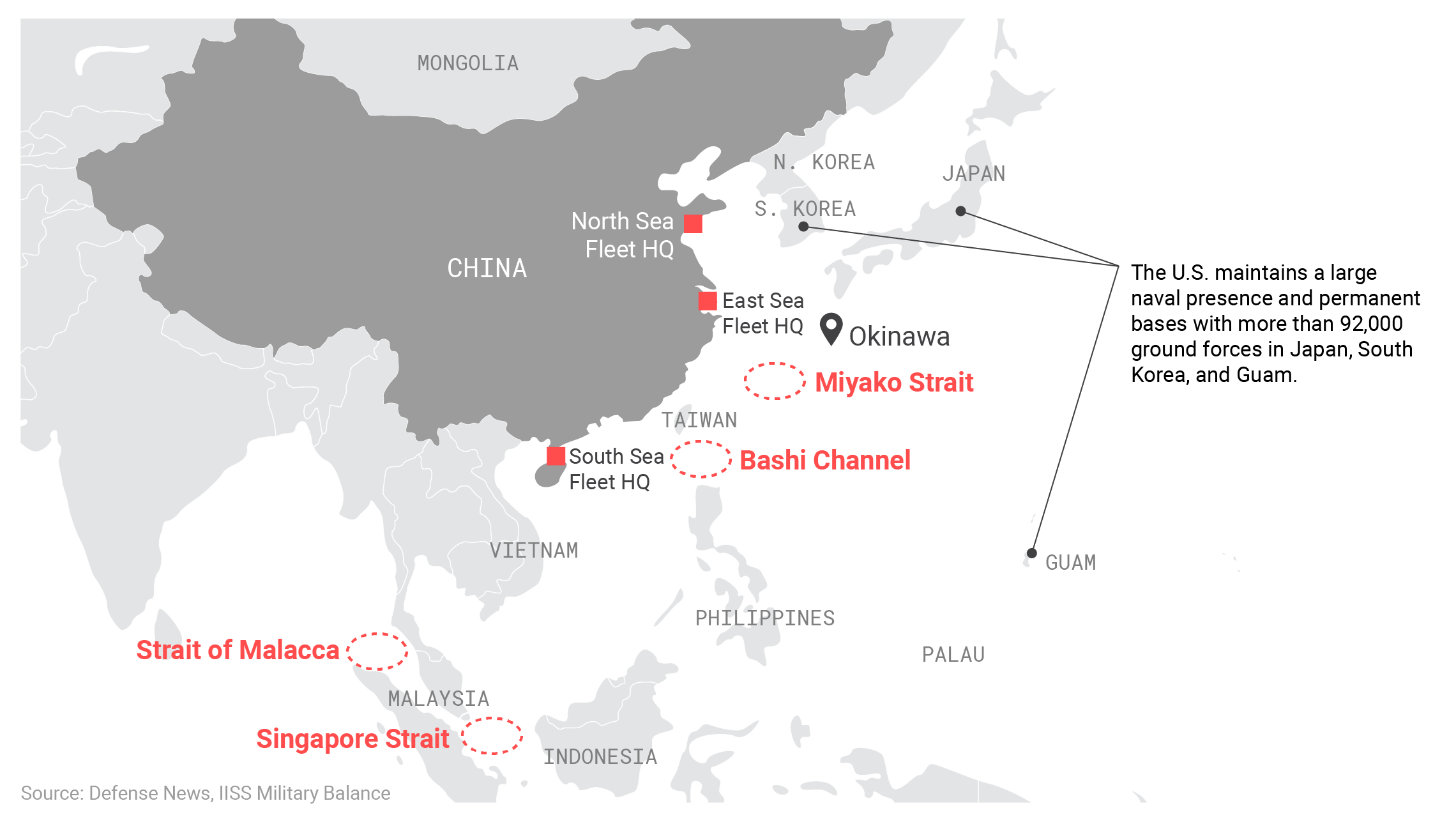
Geographic chokepoints limit China’s ability to reach the wider Pacific and Indian Oceans.
In another example of the inevitable Cold War analogies that populate discussion of the U.S.-China military balance, the Miyako/Bashi route mirrors properties of the passageways between Greenland and Iceland and Iceland and the United Kingdom (the so-called GIUK Gap) during the U.S.-Soviet struggle. That is, they are known chokepoints through which the adversary’s naval forces must flow to reach the deep sanctuary of the main ocean (the Pacific in this case instead of the Atlantic in the instance of the GIUK Gap).43Cote, “Assessing the Undersea Balance between the U.S. and China,” 12. That the U.S. has already wired the first island chain with SOSUS and presumably other undersea sensors only promulgates the comparison.
From the Chinese perspective, securing the first island chain is less about attaining some coveted prize than removing a barrier.
It is significant, in this regard, to note the concept of the first island chain did not originate with Chinese military thinkers. It was adapted from Western strategists who wanted to leverage the Pacific’s geography for precisely for what is being discussed here: hemming in China. Allen Foster Dulles is often ascribed authorship of the concept in Chinese writings, which emphasize the island chain theory originated in the 1950s as a means of blocking the Pacific communist countries (primarily the PRC and USSR) from attaining greater access to the deep-water ocean.44The origin of the concept is sometimes also ascribed to contemporaries of Dulles, including George Kennan, Dean Acheson, and Douglas MacArthur, though Dulles is usually favored in Chinese writings as the progenitor. See the discussion in Andrew S. Erickson and Joel Wuthnow, “Barriers, Springboards and Benchmarks: China Conceptualizes the Pacific ‘Island Chains,’” China Quarterly, January 2016, 5–6, https://apps.dtic.mil/dtic/tr/fulltext/u2/1002513.pdf.
China can attempt to dominate the first island chain but doing so exclusively from the sea will be remarkably taxing. More likely, it will continue to rely on a strategy of sea denial—hoping its A2/AD capabilities live up to the hype—rather than one of express sea control. The problem for the Chinese, and the advantage for the U.S. and balancing Asian nations, is that the first island chain facilitates the creation of an opposing A2/AD system of their own sensors and missiles to harass, inhibit, and possibly deny outright Chinese naval activity.
Implementation of such a system is far from mature, however, and more careful thought is needed in terms of how much of the A2/AD architecture the U.S. should operate directly and how much can be embedded more effectively (and economically) with other regional states.45For an extended discussion of the benefits of relying more on regional allies to assume the primary burden of anti-access technologies, see Eugene Gholz, Benjamin Friedman, and Enea Gjoza, “Defensive Defense: A Better Way to Protect U.S. Allies in Asia,” Washington Quarterly 42, no. 4, (Winter 2020): 171–189. Regardless, the point remains the first island chain is a fixed variable, one that will continue to serve as a break on Chinese maritime ambitions even if it pursues better procurement choices and masters its own set of A2/AD technologies. In the end, dueling A2/AD systems could render much of the East Asian littoral “No Man’s Seas”—bodies of water in which neither side can operate with a reasonable expectation of safety.46See the unpublished paper by Eugene Gholz, “No Man’s Sea: Implications for Strategy and Theory,” presented March 2016 at the annual meeting of the International Studies Association in Atlanta, Georgia, as referenced in Gholz, Friedman, and Gjoza, “Defensive Defense.”
Shallow waters shape the undersea battlefield
Another aspect of geography worth discussing here involves what lies below the surface. The three main bodies that constitute the bulk of the East Asian littoral waters—the Yellow Sea, the East China Sea, and the South China Sea—are all relatively shallow for the most part. This is particularly true of the Yellow Sea, which has average depths ranging from only 200 to 260 feet.47Mark J. Valencia and Michitaka Uda, “Yellow Sea,” Encyclopedia Britannica, accessed September 4, 2020, https://www.britannica.com/place/Yellow-Sea. The East China Sea does feature deep channels immediately abutting the Ryukyus, but otherwise has an average depth of only around 650 feet.48Eugen C. LaFond, “East China Sea,” Encyclopedia Britannica, accessed September 4, 2020, https://www.britannica.com/place/East-China-Sea. The South China Sea is deep at points, especially in the center, but in the south and along its entire perimeter (including the Chinese coastline and the Taiwan Strait) is also quite shallow.
This is important because of the challenges to active and passive sonar shallow waters present.49Cote, “Assessing the Undersea Balance between the U.S. and China,” 3, 6–9; William A. Kuperman and James A. Lynch, “Shallow-Water Acoustics,” Physics Today 57, no. 10 (October 2004): 55–61, https://physicstoday.scitation.org/doi/10.1063/1.1825269. Low depths can adversely affect signal reflection and produce distortions, garbling the acoustic picture underneath the water for both surface and subsurface vessels.
Submarines are far from invulnerable in these conditions, but detection, tracking, and targeting of undersea assets are all negatively affected. Coupled with the high background noise from the large volume of commercial shipping transiting the region, the East Asia littoral becomes an extremely challenging ASW environment. Chinese ability to guarantee an operating environment free from sub-surface threats is therefore questionable, despite their recent investments in ASW ships and the deployment of their own undersea sensor net.50H. I. Sutton, “China Builds Surveillance Network in the South China Sea,” Forbes, August 5, 2020, https://www.forbes.com/sites/hisutton/2020/08/05/china-builds-surveillance-network-in-international-waters-of-south-china-sea/#7c96d59774f3.
This, of course, is sauce for the gander as well. U.S. forces entering the East Asian littoral waters will also face a significant ASW challenge, perhaps even more so if they are not able to safely employ air assets such as the P-8 maritime patrol aircraft. And while Chinese nuclear submarines have a number of deficiencies, the PLAN does operate some high-quality SSKs, such as imported Russian Kilos and the indigenously produced Yuan, that have excellent quieting levels.51One analyst has referred to the Yuan as “the sharpest spear in China’s naval arsenal” due to its quieting levels and ability to launch the YJ-18 ASCM. See Goldstein, “The U.S.-China Naval Balance in the Asia-Pacific: An Overview,” 916.
But U.S. surface forces do not have to operate specifically in littoral waters during a conflict in the Western Pacific, whereas Chinese forces do by virtue of the location of their homeports and potentially their objective (e.g., Taiwan). The need for sea control—both above and below the waves—is greater for Chinese forces, especially if they were to attempt something as bold as an amphibious invasion of Taiwan or another act of major maritime aggression.
The capabilities of other regional states
The second immutable factor is China’s maritime forces do not operate in a vacuum nor exclusively in opposition to the U.S. Navy. Some Western writers have drawn comparisons between China’s bid to turn the South China Sea into a “Chinese lake” and America’s consolidation of control over the Caribbean Sea following its victory in the Spanish-American War.52James R. Holmes and Toshi Yoshihara, “China’s ‘Caribbean’ in the South Sea,” SAIS Review of International Affairs XXVI, no. 1 (Winter–Spring 2006): 79–92. For the U.S., mastering its own maritime backyard was a necessary stepping stone for great naval dominance abroad. However, America only had to contend with distant powers—evicting Spain from Cuba and ultimately supplanting Great Britain as the area’s dominant naval force. It did not need to worry about a substantial Mexican fleet or the naval forces of a major South American power.
Annual defense spending of China and regional neighbors
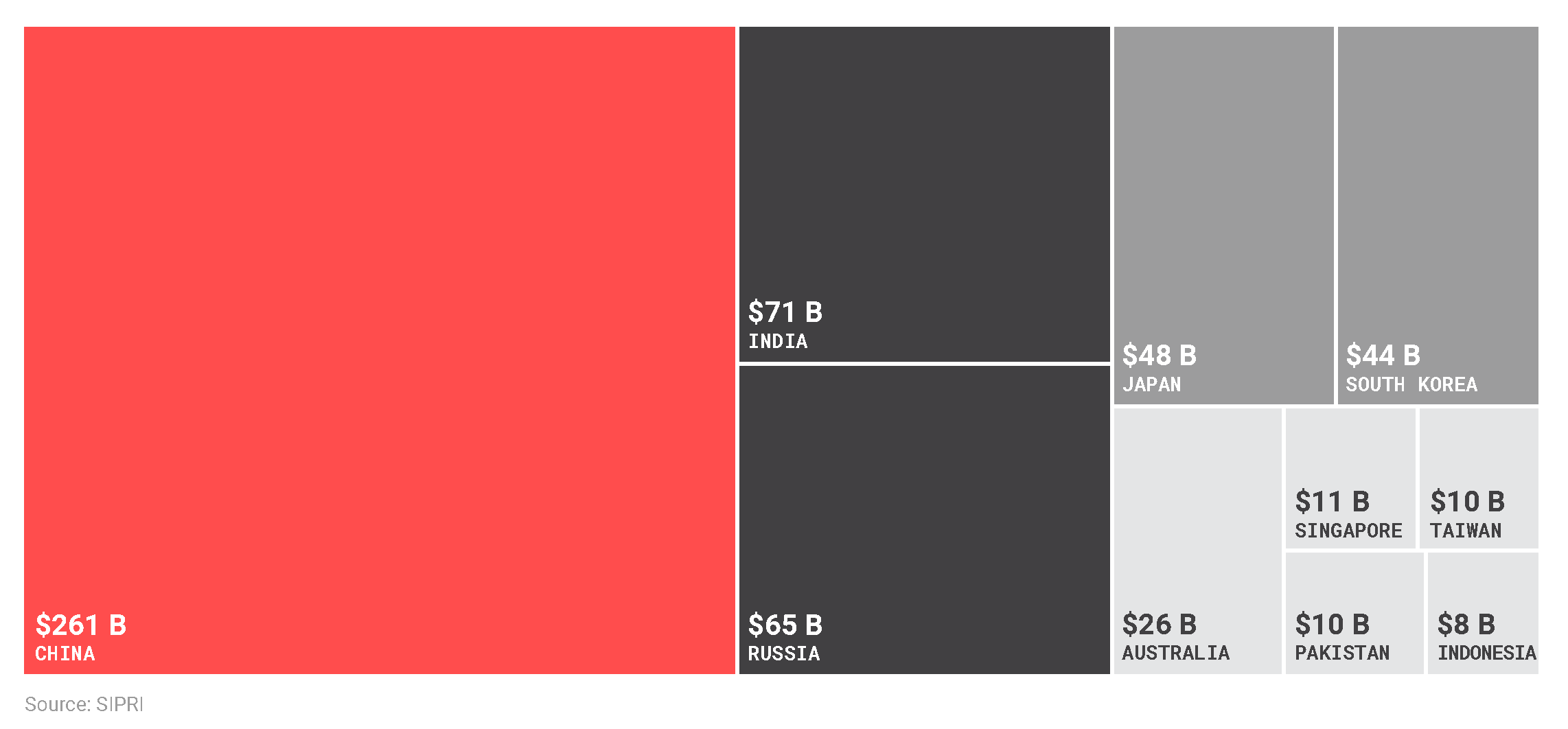
China’s defense spending was $261 billion in 2019. Without factoring in the U.S., China is currently outspent by the combined spending of the next nine largest military spenders in the region.
China’s situation in the East Asian littoral is quite different.53For an extended discussion of how China’s regional neighborhood limits its maritime ambitions, see Beckley, “The Emerging Military Balance in Asia,” 78–119. It is ringed by a number of other major, middle, and minor powers, including three nuclear states (India, North Korea, and Russia) and the owner of the world’s third largest economy, Japan. Even smaller states in the region can bring to bear submarine and anti-ship missiles in niche roles.
Take China’s immediate neighbor, Vietnam. Although Hanoi has limited surface combatants, it possesses 35 Su-30 fourth-generation fighters, which can be armed with Kh-31 supersonic anti-ship missiles.54Beckley, “The Emerging Military Balance in Asia,” 100. It also deploys six Kilo-class diesel submarines purchased over the last decade from Russia.55Prashanth Parameswaran, “Vietnam Gets Fifth Submarine from Russia,” Diplomat, February 10, 2016, https://thediplomat.com/2016/02/vietnam-gets-fifth-submarine-from-russia/. Added to this are batteries of advanced shore-based anti-ship missiles, the Russian P-800, which can strike targets up to 230 miles from the Vietnamese coast.56Felix K. Chang, “Resist and Reward: Vietnam’s Naval Expansion,” Foreign Policy Research Institute, November 6, 2019, https://www.fpri.org/article/2019/11/resist-and-reward-vietnams-naval-expansion/. In truth, these assets hardly give Vietnam a chance against China in a sustained maritime conflict. But they create sufficient punch Vietnam could hurt China enough to deter it.
The geographic restrictions of the East Asian littoral mean states with extremely limited military capabilities can still implement their own modest sea denial strategy through selective use of advanced missiles and submarines, deployed at the region’s many chokepoints. This is why the dozen or so diesel electric submarines operated by Singapore, Malaysia, and Indonesia are not insignificant to this discussion.57Singapore and Malaysia each operate four diesel electric submarines while Indonesia has five. For specific details on their individual characteristics, see “Singapore Submarine Capabilities,” Nuclear Threat Initiative, October 16, 2019, https://www.nti.org/analysis/articles/singapore-submarine-capabilities/; “Malaysia Submarine Capabilities,” Nuclear Threat Initiative, October 16, 2019, https://www.nti.org/analysis/articles/malaysia-submarine-capabilities/; “Indonesia Submarine Capabilities,” Nuclear Threat Initiative, October 17, 2019, https://www.nti.org/analysis/articles/indonesia-submarine-capabilities/. Their presence at southern chokepoints along the South China Sea (and especially in the vicinity of the Singapore Strait and the Strait of Malacca) endows them with outsized importance. They cannot defeat the PLAN, but they can complicate its operations.
Significantly, Taiwan seems to be embracing this concept as well, recently agreeing to a $7 billion arms sale from the U.S. explicitly focused on asymmetric anti-access capabilities like drones, sea mines, and anti-ship missiles.58Demetri Sevastapulo and Kathrin Hille, “U.S. Plans $7bn Arms Deal with Taiwan as China Ratchets Up Military Threat,” Financial Times, September 17, 2020, https://www.ft.com/content/f4b2696b-a960-40f0-85db-1bf9fd6d0b7b.
Elsewhere in the Pacific, Australia has committed to buying the AGM-158C long-range anti-ship missile from the U.S. in the face of deteriorating relations with Beijing; Canberra is also exploring options to purchase future U.S. hypersonic missiles currently in development.59Malcolm Davis, “Australia Is Getting the Long-range Missiles Needed for a Contested Indo-Pacific,” Strategist, July 2, 2020, https://www.aspistrategist.org.au/australia-is-getting-the-long-range-missiles-needed-for-a-contested-indo-pacific/. Again, these capabilities will not single-handedly thwart Chinese naval ambitions, but they represent another niche challenge with which the PLAN must contend.
South Korea’s air and sea capabilities—admittedly primarily focused on North Korea—are also an important factor. To cite the most salient example, Seoul recently announced plans to build its own light aircraft carrier, which will accommodate the Short Take Off and Landing (STOVL) iteration of the stealthy F-35.60Xavier Vavaseur, “South Korea Plans to Build F-35B Lightning Aircraft Carrier,” U.S. Naval Institute News, August 11, 2020, https://news.usni.org/2020/08/11/south-korea-plans-to-build-f-35b-lighting-aircraft-carrier.
Meanwhile, Russia has begun to resuscitate its Pacific Fleet after a prolonged period of neglect. In 2020, the force is scheduled to receive 15 new combat and supply ships, primarily missile-carrying corvettes and frigates.61Peter Suciu, “Russia’s Pacific Fleet Is Getting Stronger. Here’s Why That Matters.” National Interest, June 2, 2020, https://nationalinterest.org/blog/buzz/russias-pacific-fleet-getting-stronger-heres-why-matters-159506. As well, six of the Project 636.3 versions of the Kilo-class submarine (i.e., the latest, quietest iteration of the venerable SSK) will also be deployed at Far East bases, where they will join a force that already includes four Akula SSNs and five Oscar II SSGNs.62An “SSGN” is a nuclear-powered submarine that carries a load-out of conventionally armed cruise missiles, primarily anti-ship in the Russian case. Submarine force levels taken from Suciu, “Russia’s Pacific Fleet is Getting Stronger,” and Office of Naval Intelligence, “Russian Major Naval Force by Fleet (continue),” Office of Naval Intelligence, 2019, https://www.oni.navy.mil/News/Naval-Capabilities/Russia/.
India also must be counted in this discussion of “Pacific” powers as it sits astride many of the key sea lanes along which Chinese trade and energy flow. That said, its materiel situation is unimpressive compared to China, lagging behind in terms of total ship numbers, with China fielding almost three times as many major surface combatants.63“Table F-1. Comparison of China’s and India’s Military Assets,” in Library of Congress, Congressional Research Service, “China-India Great Power Competition in the Indian Ocean Region: Issues for Congress” (R45194), April 20, 2018, 48, https://fas.org/sgp/crs/row/R45194.pdf.
But if one looks at the long game, India has the potential to develop its naval forces if it opts to do so. China’s own impressive modernization program over the past two decades shows it is possible to transform maritime capabilities in what, in the life of a nation, is a relatively short time. The point worth emphasizing is India, like China’s other neighbors, is not going anywhere. Beijing will always have to deal with proximate, powerful states in a way previous naval powers—like the U.S. in the Western Hemisphere—did not.
Finally, in that regard, there is Japan. There is no doubt China’s modernization program has recast the Asian maritime power landscape. Nowhere is this more apparent than the PLAN supplanting the Japanese Maritime Self Defense Force (JMSDF) as the region’s largest indigenous navy by total tonnage and also in terms of overall firepower.64The PLAN currently has 40 percent more aggregate tonnage than the JMSDF; more damning for the Japanese side is that China has blown by it in the number of vertical launch system (VLS) tubes it can bring to bear, fielding 75 percent more VLS cells in its fleet than Japan. Still worse, many of the Chinese anti-ship missiles that can be fired from VLS have much longer ranges than their Japanese counterparts. See the discussion in Yoshihara, “Dragon Against the Sun,” 12–19. Yet Japan’s capabilities remain significant, including four helicopter carriers, two cruisers, 45 destroyers and frigates, and 21 submarines, 11 of which are super-quiet Soryu-class SSKs.65Toshi Yoshihara, “How China Has Overtaken Japan in Naval Power and Why it Matters,” Maritime Executive, July 5, 2020, https://www.maritime-executive.com/editorials/how-china-has-overtaken-japan-in-naval-power-and-why-it-matters; Fraz-Stefan Gady, “Japan’s First Soryu-Class Attack Sub Fitted with Lithium-Ion Batteries Arrives at Homeport,” Diplomat, April 8, 2020, https://thediplomat.com/2020/04/japans-first-soryu-class-attack-sub-fitted-with-lithium-ion-batteries-arrives-at-homeport/. Additionally, in July the U.S. approved Japanese plans to purchase 105 F-35s, which will make Japan the largest foreign operator of the stealth aircraft.66Valerie Insinna, “U.S. Gives the Green Light to Japan’s $23B F-35 Buy,” Defense News, July 9, 2020, https://www.defensenews.com/smr/2020/07/09/us-gives-the-green-light-to-japans-massive-23b-f-35-buy/.
Moreover, Tokyo can wield these assets from an advantageous geographic position vis-à-vis China and, as in the case of India, further expand its naval and air assets if it chooses to invest wisely. China might have surpassed Japan in sheer naval capacity, but the net military balance between the two states remains close and, as the preceding discussion illustrates, Japan is not the only regional state China will have to contend with in a bid for true maritime hegemony.
None of this is to suggest all of the states discussed above will necessarily work in concert or directly with the U.S. to thwart Chinese maritime potential. But it is to argue East Asia is not lacking when it comes to indigenous air and naval capabilities, beyond those of China. These various assets are tiles in a mosaic that collectively could absorb and partially blunt the impact of China’s modernization program.
Risks of overestimating Chinese maritime capabilities
Given a closer look at Chinese maritime capabilities, the picture that emerges is less an unstoppable colossus and more a powerful, but uneven force, with important capability gaps, in part reliant on a potentially lethal, but unproven concept (A2/AD) to help secure its littoral waters.
China’s is a force hemmed in by geography in a way traditional great naval powers have not been and is also embedded in a region with other powerful states who have their own important maritime capabilities with the wherewithal to further expand them in the years ahead.
China may have the capabilities to secure dominance out to the first island chain at some point in the future, but it will have a hard time extending that into complete naval hegemony over the Western Pacific. And there also remains the possibility Chinese capabilities could stagnate or regress.
The Chinese themselves invoke two future dates when speaking about their military: 2035 and 2049. The former date is the goal for completing the overall program of military modernization initiated in the 1990s. The latter is the objective date for having “a world class military.”67Office of the Secretary of Defense, “Annual Report to Congress,” vi. That term is left unspecified, but presumably would entail either attaining global parity with or surpassing U.S. capabilities. Implicit within each of these dates though is acknowledgement China’s current military (including its maritime assets) remains a work in progress. Its completion, though, is not a foregone conclusion.
Most economic models suggest China’s growth will slow over the next decade, perhaps by as much as half—dropping from the current 6.1 percent per year to around 3 percent.68Office of the Secretary of Defense, “Annual Report to Congress,” 140. This could impede China’s current pace of naval modernization, particularly as maritime capabilities remain only one budget item amongst many, with the largest outlay going toward domestic security and surveillance.69Michael Beckley, Unrivaled (Ithaca, NY: Cornell University Press, 2018), 54–56. If its economy slows, it is unlikely Beijing will be willing to spend heavily on expeditionary forces at the cost of internal stability.
And ultimately China will not be able to challenge the U.S. Navy for primacy until it secures Taiwan.70It is worth pointing out, of course, that there are other potential methods for China to subjugate Taiwanese sovereignty short of invasion. Blockade and coercive bombing/missile strikes are the most commonly discussed. But it is unclear if such actions—which face important impediments to success—would result in the physical control over the island that would be most advantageous to China, at least in terms of maritime geography. For an exploration of blockade and coercive bombing scenarios, see Hunzeker and Lanoszka, A Question of Time, 50–53. This is not meant as a taunt, but rather as an acknowledgment of the central role Taiwan plays in maritime geography for China. Taiwan itself does not give China the Western Pacific, but it remains a necessary prerequisite to ensuring true control over the South China Sea and providing a safe springboard into the rest of the Pacific. For all the reasons discussed above, conquest of Taiwan is unlikely to happen in the near future.
And even if it does at some point, the costs of garrisoning that island could in themselves exact a high toll on Chinese military spending. When one considers the challenges China has faced in integrating the far smaller and closer Hong Kong over a 23-year period, it is possible to see how costly and time-consuming bringing the Taiwanese people to heel might be.
All of this affords the U.S. time to weigh the situation dispassionately and assess how deeply it must commit militarily. At various points during the actual Cold War, each side misread the other’s military capabilities and it only deepened the conflict. Patience, rather than panic, might better serve the U.S. now.
Endnotes
- 1It should be noted there is some room for interpretation in these figures, as the U.S. Navy counts certain ships as “battle force,” such as auxiliary and supply, while China does not; however, the PLAN does count patrol craft, unlike the U.S. Navy. See “Table 2. Numbers of Battle Force Ships, 2000–2030,” in U.S. Library of Congress, Congressional Research Service, “China Naval Modernization: Implications for U.S. Navy Capabilities—Background and Issues for Congress” (RL33153), August 24, 2020, 29–30, https://fas.org/sgp/crs/row/RL33153.pdf. A DoD assessment released in September 2020 offered a similar but slightly different tally of 350 PLAN ships versus 293 for the U.S. Navy. See Office of the Secretary of Defense, “Annual Report to Congress: Military and Security Developments Involving the People’s Republic of China,” Government Printing Office, 2020, ii.
- 2Dennis J. Blasko, Phillip T. Klapakis, and John F. Corbett, Jr., “Training Tomorrow’s PLA: A Mixed Bag of Tricks,” China’s Military in Transition, eds. David Shambaugh and Richard H. Yang (New York: Oxford University Press, 1997), 253.
- 3This is a point repeatedly touched on in Office of the Secretary of Defense, “Annual Report to Congress.”
- 4This point was made by Secretary of Defense Mark Esper in a recent speech. In his words, “I want to make clear that China cannot match the United States when it comes to naval power. Even if we stopped building new ships, it would take the PRC years to close the gap when it comes to our capability on the high seas. Ship numbers are important, but they don’t tell the whole story. They do not address the types of ships and the capabilities of the vessels being counted; the skill of the crews that operate them; the prowess of the officers that lead them; or the ways in which we fight and sustain them … just to name a few.” See Mark T. Esper, “Secretary of Defense Speech at RAND (As Delivered),” U.S. Department of Defense, September 16, 2020, https://www.defense.gov/Newsroom/Speeches/Speech/Article/2350362/secretary-of-defense-speech-at-rand-as-delivered/.
- 5Daniel L. Davis, “Responsibly Competing with China,” Defense Priorities, July 2020, https://www.defensepriorities.org/explainers/responsibly-competing-with-china.
- 6Toshi Yoshihara, Dragon Against the Sun: Chinese Views of Japanese Maritime Seapower (Washington, DC: Center for Strategic and Budgetary Assessments, 2020), 12–15, https://csbaonline.org/research/publications/dragon-against-the-sun-chinese-views-of-japanese-seapower/publication/1.
- 7See the discussion of the YJ-18 versus Harpoon ranges in Yoshihara, Dragon Against the Sun, 16; Lyle Goldstein, “The U.S.-China Naval Balance in the Asia-Pacific: An Overview,” China Quarterly, no. 232 (December 2017): 912–913.
- 8Congressional Research Service, “China Naval Modernization,” 11–13.
- 9Congressional Research Service, “China Naval Modernization,” 13.
- 10China has laid the keel down on its first flat-deck carrier, which will approach its U.S. counterparts in size, though is not expected to be nuclear. It is also believed to be fitted with catapult launch systems, possibly electro-magnetic ones like those employed by the U.S. Navy’s newest carrier, the USS Gerald Ford. But this third carrier is not yet a demonstrated capability—or a fleet. The carrier is not anticipated to be operational until 2024, and that assumes China is able to master catapult technology without any complications—something that bedeviled the Ford’s development. Even then, one carrier would only be available for part of the year due to maintenance and training requirements. See Office of the Secretary of Defense, “Annual Report to Congress,” 47; Gary Shih, “China’s Third Aircraft Carrier Takes Shape, with Ambitions to Challenge U.S. Naval Dominance,” Washington Post, September 16, 2020, https://www.washingtonpost.com/world/asia_pacific/chinas-third-aircraft-carrier-takes-shape-with-ambitions-to-challenge-us-naval-dominance/2020/09/16/d1068f8c-f674-11ea-85f7-5941188a98cd_story.html.
- 11Owen R. Cote, Jr., “Assessing the Undersea Balance between the U.S. and China,” MIT Security Studies Program (SSP) Working Paper, February 2011, 11–12, https://www.usni.org/sites/default/files/inline-files/Undersea%20Balance%20WP11-1.pdf.
- 12Cote, “Assessing the Undersea Balance between the U.S. and China,” 7.
- 13For a full discussion on the SOSUS “fishhook,” including a map of its coverage, see Desmond Ball and Richard Tanter, The Tools of Owatatsumi: Japan’s Ocean Surveillance and Coastal Defence Capabilities (Canberra: Australian National University Press, 2015), 51–54.
- 14Regarding the Jin’s quieting characteristics, see the chart “Submarine Quieting Trends” in Office of Naval Intelligence, “The People’s Liberation Army Navy: A Modern Navy with Chinese Characteristics,” August 2009, https://fas.org/irp/agency/oni/pla-navy.pdf; Jeffrey Lewis, “How Capable Is the Type 094?” Arms Control Wonk, July 31, 2007, https://www.armscontrolwonk.com/archive/201579/how-capable-is-the-094-23/; and Hans M. Kristensen, “China’s Noisy Nuclear Submarines,” Federation of Atomic Scientists, November 21, 2009, https://fas.org/blogs/security/2009/11/subnoise/.
- 15DoD estimates that more than half of the PLAAF’s and PLAN’s fighter inventory consists of modern fourth-generation aircraft (like the Su-27 and its variants), specifically about 800 out of total 1,500 planes. See Office of the Secretary of Defense, “Annual Report to Congress,” 50.
- 16See, for example, the comments by Michael Kofman in Daniel Brown, “We Asked a Military Analyst How the F-22, Su-57, and J-20 Stealth Planes Match Up,” Business Insider, March 7, 2018, https://www.businessinsider.com/comparison-of-f-22-su-57-and-j-20-stealth-planes-2018-3.
- 17Alternate engines for the J-20 have included Russian imports and the domestically produced engine for the J-16, but neither is explicitly designed for the J-20. For more on the challenges affecting development of the J-20’s intended engine and discussion of alternate domestic and Russian substitutes, see Kofman’s comments in Brown, “We Asked a Military Analyst”; Caleb Larson, “China’s J-20 Stealth Fighter is Getting an Upgrade—Thanks to Russia,” National Interest, July 20, 2020, https://nationalinterest.org/blog/buzz/china%E2%80%99s-j-20-stealth-fighter-getting-upgrade%E2%80%94thanks-russia-165242; Rick Joe, “China’s J-20 Stealth Fighter Today and Into the 2020s,” Diplomat, August 16, 2019, https://thediplomat.com/2019/08/chinas-j-20-stealth-fighter-today-and-into-the-2020s/.
- 18Michael R. Gordon and Bernard E. Trainor, The Generals’ War (New York: Little, Brown, and Company), 1995, 57.
- 19This was a particular source of ire for General Norman Schwarzkopf, who lamented the Navy’s paucity of minesweepers and inability to clear Iraqi sea mines in support of a planned amphibious landing during the 1991 Gulf War. Instead, the Navy suffered two ships damaged to mines, including a new Aegis cruiser, the USS Princeton, and the ship leading the mine-clearing effort, the USS Tripoli. See Rick Atkinson, Crusade: The Untold Story of the Persian Gulf War (New York: Houghton Mifflin Company, 1993), 237–240, 321–330.
- 20Rick Joe, “China’s Growing Anti-Submarine Warfare Capabilities,” Diplomat, September 12, 2018, https://thediplomat.com/2018/09/the-chinese-surface-fleets-growing-anti-submarine-warfare-capabilities/.
- 21For a detailed listing of the PLAN’s new ASW vessels, see Joe, “China’s Growing Anti-Submarine Warfare Capabilities.”
- 22For an overview of the San Luis’ exploits, see Sebastien Roblin, “In 1982, One Diesel Submarine Took on the Royal Navy (And Survived),” National Interest, August 2, 2018, https://nationalinterest.org/blog/buzz/1982-one-diesel-submarine-took-royal-navy-and-survived-27596.
- 23David Axe, “The U.S. Can Send Hundreds of Aerial Tankers into a War Over Taiwan. The Chinese Can Send Maybe 13,” Forbes, July 18, 2020, https://www.forbes.com/sites/davidaxe/2020/07/18/the-americans-can-send-hundreds-of-aerial-tankers-into-a-war-over-taiwan-the-chinese-can-send-three/#1cd8291220dd.
- 24Lyle J. Goldstein, “China’s Y-20 Transport Plane: Sending Coronavirus Supplies and Refueling Bombers?” National Interest, March 22, 2020, https://nationalinterest.org/blog/buzz/chinas-y-20-transport-plane-sending-coronavirus-supplies-and-refueling-bombers-135927.
- 25Axe, “The U.S. Can Send Hundreds of Aerial Tankers into a War Over Taiwan.”
- 26David Lague, “China Expands Its Amphibious Forces in Challenge to U.S. Supremacy Beyond Asia,” Reuters, July 20, 2020, https://www.reuters.com/investigates/special-report/china-military-amphibious/.
- 27Lague, “China Expands Its Amphibious Forces in Challenge to U.S. Supremacy Beyond Asia.”
- 28Lague, “China Expands Its Amphibious Forces in Challenge to U.S. Supremacy Beyond Asia.”
- 29For an extended discussion of scenarios for a Chinese invasion of Taiwan and the impact of Chinese deficiencies in sealift, see Michael Hunzeker and Alexander Lanoszka, A Question of Time: Enhancing Taiwan’s Conventional Deterrence Posture (Arlington, VA: Center for Security Policy Studies, November 2018), 53–57, http://csps.gmu.edu/wp-content/uploads/2018/11/A-Question-of-Time.pdf.
- 30International Institute for Strategic Studies (IISS), The Military Balance 2017 (London: International Institute for Strategic Studies, 2017), 331, as quoted in Michael Beckley, “The Emerging Military Balance in Asia,” International Security 42, no. 2 (Fall 2017): 87, https://www.mitpressjournals.org/doi/full/10.1162/ISEC_a_00294.
- 31Beckley, “The Emerging Military Balance in Asia,” 89.
- 32Hunzeker and Lanoszka, A Question of Time, 55.
- 33According to OSD’s 2020 assessment of Chinese military capabilities, China’s acquisition trends with regard to its amphibious fleet indicate “a near term focus on regional and eventually global expeditionary missions rather than the large number of landing ship transports and medium landing craft that would be necessary for a large-scale direct beach assault. There is also no indication China is significantly expanding its force of LSTs and medium sized landing craft at this time—suggesting a direct beach-assault operation requiring extensive lift is less likely in planning.” See Office of the Secretary of Defense, “Annual Report to Congress,” 117.
- 34For a more extensive discussion of the technological challenges inherent in extending the A2/AD bubble out into the Western Pacific, see Steven Biddle and Ivan Oelrich, “Future Warfare in the Western Pacific,” International Security 41, no. 1 (Spring 2016): 7–48.
- 35The range of 400 to 600 km (approximately 250 to 370 miles) is employed in Biddle and Oelrich, “Future Warfare in the Western Pacific,” 13.
- 36See the contribution by Craig Neuman in Andrew S. Erickson, Evan Braden Montgomery, Craig Neuman, Stephen Biddle, and Ivan Oelrich, “Correspondence: How Good Are China’s Antiaccess/Area-Denial Capabilities?” International Security 41, no. 4 (Spring 2017): 207–208.
- 37Office of the Secretary of Defense, “Annual Report to Congress,” 56.
- 38Office of the Secretary of Defense, “Annual Report to Congress,” 56.
- 39“Jane’s Strategic Weapons Systems: Offensive Weapons, China, DF-26,” September 11, 2015, 2, quoted in Jordan Wilson, “China’s Expanding Ability to Conduct Conventional Missile Strikes on Guam,” U.S.-China Economic and Security Review Commission, May 10, 2016, 8, https://www.uscc.gov/research/chinas-expanding-ability-conduct-conventional-missile-strikes-guam.
- 40CEP is defined as follows: if a number of missiles are fired at a target, half of them will land within a circle with the target at its center and a radius equal to the CEP. Thus, in the example of the DF-26, if the CEP is 150 meters, that circle is 300 meters in diameter, or roughly 500 feet across; if the CEP is closer to 450 meters, the circle is nearly 1,500 feet wide. And half the missiles will land outside that circle. If the DF-26’s actual CEP is toward the larger end of that spectrum, it could impede its true effectiveness even against fixed targets, while hitting a moving one like a carrier becomes a true matter of luck.
- 41Put differently, the island of Guam itself could suffer the DF-26’s wrath, but the missile might not be able to consistently hit the specific facilities on Andersen Air Force Base needed to impede U.S. operations. Cratering runways to the point where they are irreparably inoperable, for example, is a challenging task, as various U.S. bombing efforts have shown in recent decades. Also, the U.S. does base a THAAD battery on Guam and could have U.S. Navy missile defense assets at sea that might at least partially degrade the effectiveness of DF-26 attacks.
- 42For an extended discussion of the maritime geography of the South China Sea, see James R. Holmes, “Strategic Features of the South China Sea: A Tough Neighborhood for Hegemons,” Naval War College Review 67, no. 2 (Spring 2014): 30–51.
- 43Cote, “Assessing the Undersea Balance between the U.S. and China,” 12.
- 44The origin of the concept is sometimes also ascribed to contemporaries of Dulles, including George Kennan, Dean Acheson, and Douglas MacArthur, though Dulles is usually favored in Chinese writings as the progenitor. See the discussion in Andrew S. Erickson and Joel Wuthnow, “Barriers, Springboards and Benchmarks: China Conceptualizes the Pacific ‘Island Chains,’” China Quarterly, January 2016, 5–6, https://apps.dtic.mil/dtic/tr/fulltext/u2/1002513.pdf.
- 45For an extended discussion of the benefits of relying more on regional allies to assume the primary burden of anti-access technologies, see Eugene Gholz, Benjamin Friedman, and Enea Gjoza, “Defensive Defense: A Better Way to Protect U.S. Allies in Asia,” Washington Quarterly 42, no. 4, (Winter 2020): 171–189.
- 46See the unpublished paper by Eugene Gholz, “No Man’s Sea: Implications for Strategy and Theory,” presented March 2016 at the annual meeting of the International Studies Association in Atlanta, Georgia, as referenced in Gholz, Friedman, and Gjoza, “Defensive Defense.”
- 47Mark J. Valencia and Michitaka Uda, “Yellow Sea,” Encyclopedia Britannica, accessed September 4, 2020, https://www.britannica.com/place/Yellow-Sea.
- 48Eugen C. LaFond, “East China Sea,” Encyclopedia Britannica, accessed September 4, 2020, https://www.britannica.com/place/East-China-Sea.
- 49Cote, “Assessing the Undersea Balance between the U.S. and China,” 3, 6–9; William A. Kuperman and James A. Lynch, “Shallow-Water Acoustics,” Physics Today 57, no. 10 (October 2004): 55–61, https://physicstoday.scitation.org/doi/10.1063/1.1825269.
- 50H. I. Sutton, “China Builds Surveillance Network in the South China Sea,” Forbes, August 5, 2020, https://www.forbes.com/sites/hisutton/2020/08/05/china-builds-surveillance-network-in-international-waters-of-south-china-sea/#7c96d59774f3.
- 51One analyst has referred to the Yuan as “the sharpest spear in China’s naval arsenal” due to its quieting levels and ability to launch the YJ-18 ASCM. See Goldstein, “The U.S.-China Naval Balance in the Asia-Pacific: An Overview,” 916.
- 52James R. Holmes and Toshi Yoshihara, “China’s ‘Caribbean’ in the South Sea,” SAIS Review of International Affairs XXVI, no. 1 (Winter–Spring 2006): 79–92.
- 53For an extended discussion of how China’s regional neighborhood limits its maritime ambitions, see Beckley, “The Emerging Military Balance in Asia,” 78–119.
- 54Beckley, “The Emerging Military Balance in Asia,” 100.
- 55Prashanth Parameswaran, “Vietnam Gets Fifth Submarine from Russia,” Diplomat, February 10, 2016, https://thediplomat.com/2016/02/vietnam-gets-fifth-submarine-from-russia/.
- 56Felix K. Chang, “Resist and Reward: Vietnam’s Naval Expansion,” Foreign Policy Research Institute, November 6, 2019, https://www.fpri.org/article/2019/11/resist-and-reward-vietnams-naval-expansion/.
- 57Singapore and Malaysia each operate four diesel electric submarines while Indonesia has five. For specific details on their individual characteristics, see “Singapore Submarine Capabilities,” Nuclear Threat Initiative, October 16, 2019, https://www.nti.org/analysis/articles/singapore-submarine-capabilities/; “Malaysia Submarine Capabilities,” Nuclear Threat Initiative, October 16, 2019, https://www.nti.org/analysis/articles/malaysia-submarine-capabilities/; “Indonesia Submarine Capabilities,” Nuclear Threat Initiative, October 17, 2019, https://www.nti.org/analysis/articles/indonesia-submarine-capabilities/.
- 58Demetri Sevastapulo and Kathrin Hille, “U.S. Plans $7bn Arms Deal with Taiwan as China Ratchets Up Military Threat,” Financial Times, September 17, 2020, https://www.ft.com/content/f4b2696b-a960-40f0-85db-1bf9fd6d0b7b.
- 59Malcolm Davis, “Australia Is Getting the Long-range Missiles Needed for a Contested Indo-Pacific,” Strategist, July 2, 2020, https://www.aspistrategist.org.au/australia-is-getting-the-long-range-missiles-needed-for-a-contested-indo-pacific/.
- 60Xavier Vavaseur, “South Korea Plans to Build F-35B Lightning Aircraft Carrier,” U.S. Naval Institute News, August 11, 2020, https://news.usni.org/2020/08/11/south-korea-plans-to-build-f-35b-lighting-aircraft-carrier.
- 61Peter Suciu, “Russia’s Pacific Fleet Is Getting Stronger. Here’s Why That Matters.” National Interest, June 2, 2020, https://nationalinterest.org/blog/buzz/russias-pacific-fleet-getting-stronger-heres-why-matters-159506.
- 62An “SSGN” is a nuclear-powered submarine that carries a load-out of conventionally armed cruise missiles, primarily anti-ship in the Russian case. Submarine force levels taken from Suciu, “Russia’s Pacific Fleet is Getting Stronger,” and Office of Naval Intelligence, “Russian Major Naval Force by Fleet (continue),” Office of Naval Intelligence, 2019, https://www.oni.navy.mil/News/Naval-Capabilities/Russia/.
- 63“Table F-1. Comparison of China’s and India’s Military Assets,” in Library of Congress, Congressional Research Service, “China-India Great Power Competition in the Indian Ocean Region: Issues for Congress” (R45194), April 20, 2018, 48, https://fas.org/sgp/crs/row/R45194.pdf.
- 64The PLAN currently has 40 percent more aggregate tonnage than the JMSDF; more damning for the Japanese side is that China has blown by it in the number of vertical launch system (VLS) tubes it can bring to bear, fielding 75 percent more VLS cells in its fleet than Japan. Still worse, many of the Chinese anti-ship missiles that can be fired from VLS have much longer ranges than their Japanese counterparts. See the discussion in Yoshihara, “Dragon Against the Sun,” 12–19.
- 65Toshi Yoshihara, “How China Has Overtaken Japan in Naval Power and Why it Matters,” Maritime Executive, July 5, 2020, https://www.maritime-executive.com/editorials/how-china-has-overtaken-japan-in-naval-power-and-why-it-matters; Fraz-Stefan Gady, “Japan’s First Soryu-Class Attack Sub Fitted with Lithium-Ion Batteries Arrives at Homeport,” Diplomat, April 8, 2020, https://thediplomat.com/2020/04/japans-first-soryu-class-attack-sub-fitted-with-lithium-ion-batteries-arrives-at-homeport/.
- 66Valerie Insinna, “U.S. Gives the Green Light to Japan’s $23B F-35 Buy,” Defense News, July 9, 2020, https://www.defensenews.com/smr/2020/07/09/us-gives-the-green-light-to-japans-massive-23b-f-35-buy/.
- 67Office of the Secretary of Defense, “Annual Report to Congress,” vi.
- 68Office of the Secretary of Defense, “Annual Report to Congress,” 140.
- 69Michael Beckley, Unrivaled (Ithaca, NY: Cornell University Press, 2018), 54–56.
- 70It is worth pointing out, of course, that there are other potential methods for China to subjugate Taiwanese sovereignty short of invasion. Blockade and coercive bombing/missile strikes are the most commonly discussed. But it is unclear if such actions—which face important impediments to success—would result in the physical control over the island that would be most advantageous to China, at least in terms of maritime geography. For an exploration of blockade and coercive bombing scenarios, see Hunzeker and Lanoszka, A Question of Time, 50–53.
More on Asia
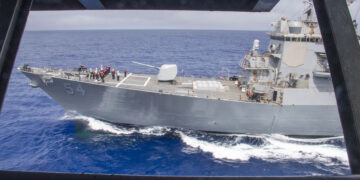
By John Mueller
April 10, 2025
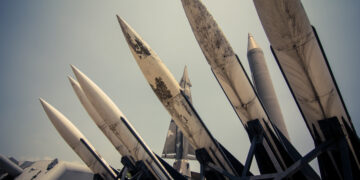
Featuring Jennifer Kavanagh
April 2, 2025

